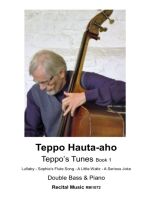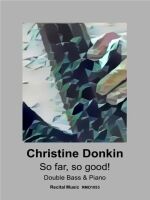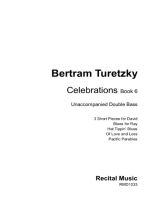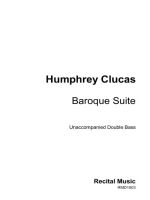Bass Clef Solos Book 2

Product code:
£12.50
Description
1) Gustav Láska (1847-1928) – A la Hongroise
A la Hongroise (in the Hungarian style) is taken from Láska’s Kontrabass-Schule Book 2 (1904) and is a fun and rhythmic work in the style of a Czardas, with a slow and evocative introduction followed by music of a fast and exciting character. The accompaniment is primarily chordal, adding colour and drive, producing a piece which is ideal for any audience or occasion.
2) Adolf Lotter (1871-1942) – The Ragtime Bass Player
The Ragtime Bass Player was composed in 1913. It was described as a characteristic novelty and was scored for full orchestra, featuring the double bass section as soloists. Composed at the height of the ragtime craze, with syncopations aplenty, the piece is lively and full of fun, very much in the salon music style of the day, but accessible for any audience and a great opportunity to feature the bass section or a single bassist as soloist.
Madenski was born in Austria, was a member of the Vienna Philharmonic Orchestra and eventually succeeded Simandl as Professor at the Vienna Conservatoire. Träumerei (Dreaming) is the first of Two Easy Concert Pieces and has a lilting and supportive accompaniment contrasting a more lyrical and song-like melody throughout the sonorous lower register of the double bass.
4) Jules Massenet (1842-1912) – Élégie
Élégie exists in a number of versions, but is known primarily as a song for voice and piano, dating from c.1872. It was an arrangement of a Mélodie (Op.10, No.5) for piano and also used as the basis for an Invocation from the incidental music to Les Érinnyes. It transcribes beautifully for the double bass and emphasises the lyrical and sonorous capabilities of the instrument in its middle register.
5) Rodolphe Kreutzer (1766-1831) – Study in A minor
František Simandl (1840-1912) transcribed 18 Etudes for double bass from Kreutzer’s 40 Études ou Caprices. Originally for violin and first published in 1805, they offer technical and musical challenges in the orchestral register of the double bass, with piano accompaniments that are simple and supportive. Playable with or without accompaniment.
6) Johannes Brahms (1833-1897) – Hungarian Dance
Hungarian Dance (Book 3, No.13) was arranged for cello and piano by Alfredo Piatti (1822-1901), a contemporary and friend of Giovanni Bottesini at Milan Conservatoire. In ternary form and offering effective musical and technical challenges, the opening section (Andante grazioso) sets the mood with a rhythmic and imposing melody, contrasting a more energetic middle section (Vivace) consisting of running semiquavers. The final section returns to the opening material but with a more lyrical and gently moving accompaniment.
7) Tommaso Giordani (1751-1794) – Caro Mio Ben
Originally for voice and strings and transcribed for cello and piano by David Popper (1843-1913), this popular arietta, composed in 1783, is attributed to Tommaso Giordani but musical scholars now believe it may have been composed by his father. The solo line is beautifully lyrical, well suited to the singing qualities of the double bass, with a colourful and inventive accompaniment which is both supportive and independent.
8) Peter Tchaikovsky (1840-1893) – Arioso
Arioso is from the cantata Moscow, composed in 1883 for the coronation celebrations of the Russian Tsar Alexander III. Originally for mezzo-soprano, Arioso is soulful and heartfelt, in the darkly hued key of E flat minor, offering musical and technical challenges in equal measure. The cantata is hardly known outside Russia but demonstrates a composer at the height of his powers and was composed in two weeks.
9) Edvard Grieg (1843-1907) – Solveig’s Song
Grieg’s incidental music to Henrik Ibsen’s play Peer Gynt was composed in 1867. Solveig’s Song is from Act 2, is influenced by folk music and is the most popular of Grieg’s 180 or so songs. The contrasting slow and faster sections offer effective and accessible musical challenges for the intermediate bassist, notably the emotional and expressive melody which begins and ends the song.
10) Eduard Mollenhauer (1827-1914) – Concert Solo
Born in German, Mollenhauer studied violin with Ernst and Spohr and first toured the US in 1853. He and his brother both settled in New York as violin teachers and Eduard performed regularly as a soloist with the New York Philharmonic Orchestra. He composed methods for the violin, viola, cello and double bass for the John Church Company (Cincinnati) and his Imperial Method for the Double Bass dates from 1898. Concert Solo is included in the double bass method and includes two endings, one using harmonics found in the lower positions and far ahead of its time. In ternary form, the piece is accessible and relaxed, with a gently supportive piano accompaniment, is a welcome ‘new’ addition to the intermediate solo repertoire.
Description
1) Gustav Láska (1847-1928) – A la Hongroise
A la Hongroise (in the Hungarian style) is taken from Láska’s Kontrabass-Schule Book 2 (1904) and is a fun and rhythmic work in the style of a Czardas, with a slow and evocative introduction followed by music of a fast and exciting character. The accompaniment is primarily chordal, adding colour and drive, producing a piece which is ideal for any audience or occasion.
2) Adolf Lotter (1871-1942) – The Ragtime Bass Player
The Ragtime Bass Player was composed in 1913. It was described as a characteristic novelty and was scored for full orchestra, featuring the double bass section as soloists. Composed at the height of the ragtime craze, with syncopations aplenty, the piece is lively and full of fun, very much in the salon music style of the day, but accessible for any audience and a great opportunity to feature the bass section or a single bassist as soloist.
Madenski was born in Austria, was a member of the Vienna Philharmonic Orchestra and eventually succeeded Simandl as Professor at the Vienna Conservatoire. Träumerei (Dreaming) is the first of Two Easy Concert Pieces and has a lilting and supportive accompaniment contrasting a more lyrical and song-like melody throughout the sonorous lower register of the double bass.
4) Jules Massenet (1842-1912) – Élégie
Élégie exists in a number of versions, but is known primarily as a song for voice and piano, dating from c.1872. It was an arrangement of a Mélodie (Op.10, No.5) for piano and also used as the basis for an Invocation from the incidental music to Les Érinnyes. It transcribes beautifully for the double bass and emphasises the lyrical and sonorous capabilities of the instrument in its middle register.
5) Rodolphe Kreutzer (1766-1831) – Study in A minor
František Simandl (1840-1912) transcribed 18 Etudes for double bass from Kreutzer’s 40 Études ou Caprices. Originally for violin and first published in 1805, they offer technical and musical challenges in the orchestral register of the double bass, with piano accompaniments that are simple and supportive. Playable with or without accompaniment.
6) Johannes Brahms (1833-1897) – Hungarian Dance
Hungarian Dance (Book 3, No.13) was arranged for cello and piano by Alfredo Piatti (1822-1901), a contemporary and friend of Giovanni Bottesini at Milan Conservatoire. In ternary form and offering effective musical and technical challenges, the opening section (Andante grazioso) sets the mood with a rhythmic and imposing melody, contrasting a more energetic middle section (Vivace) consisting of running semiquavers. The final section returns to the opening material but with a more lyrical and gently moving accompaniment.
7) Tommaso Giordani (1751-1794) – Caro Mio Ben
Originally for voice and strings and transcribed for cello and piano by David Popper (1843-1913), this popular arietta, composed in 1783, is attributed to Tommaso Giordani but musical scholars now believe it may have been composed by his father. The solo line is beautifully lyrical, well suited to the singing qualities of the double bass, with a colourful and inventive accompaniment which is both supportive and independent.
8) Peter Tchaikovsky (1840-1893) – Arioso
Arioso is from the cantata Moscow, composed in 1883 for the coronation celebrations of the Russian Tsar Alexander III. Originally for mezzo-soprano, Arioso is soulful and heartfelt, in the darkly hued key of E flat minor, offering musical and technical challenges in equal measure. The cantata is hardly known outside Russia but demonstrates a composer at the height of his powers and was composed in two weeks.
9) Edvard Grieg (1843-1907) – Solveig’s Song
Grieg’s incidental music to Henrik Ibsen’s play Peer Gynt was composed in 1867. Solveig’s Song is from Act 2, is influenced by folk music and is the most popular of Grieg’s 180 or so songs. The contrasting slow and faster sections offer effective and accessible musical challenges for the intermediate bassist, notably the emotional and expressive melody which begins and ends the song.
10) Eduard Mollenhauer (1827-1914) – Concert Solo
Born in German, Mollenhauer studied violin with Ernst and Spohr and first toured the US in 1853. He and his brother both settled in New York as violin teachers and Eduard performed regularly as a soloist with the New York Philharmonic Orchestra. He composed methods for the violin, viola, cello and double bass for the John Church Company (Cincinnati) and his Imperial Method for the Double Bass dates from 1898. Concert Solo is included in the double bass method and includes two endings, one using harmonics found in the lower positions and far ahead of its time. In ternary form, the piece is accessible and relaxed, with a gently supportive piano accompaniment, is a welcome ‘new’ addition to the intermediate solo repertoire.



